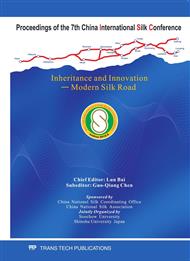p.765
p.771
p.777
p.782
p.786
p.792
p.797
p.801
p.807
How Does the Saturation Influence on the Cognition of Clothing Color? A Behavioural Study
Abstract:
In this paper, “fashionable” and “conservative” as color emotional words were used, and color piece and clothing color samples with 40 hues and 9 saturation levels were evaluated on emotional variables in behavioral trials. The purpose of the present study was to investigate how the saturation influence on the cognition of clothing color. Results showed that different saturation could be easily perceived as different emotion, and the fashionable emotion presented a weak-strong trend as the saturation increased, whereas the conservative emotion presented a reverse trend. The emotions of color pieces and clothing colors tended to be consistent. However, compared with color pieces, the clothing colors had stronger fashionable emotion. The colors of high and low saturation presented sensitivity to subjects, and the RTs (response time) were shorter in emotional evaluation. In addition, it was easier to cognize fashionable emotion than to cognize conservative emotion.
Info:
Periodical:
Pages:
786-791
Citation:
Online since:
January 2011
Authors:
Keywords:
Price:
Сopyright:
© 2011 Trans Tech Publications Ltd. All Rights Reserved
Share:
Citation:


